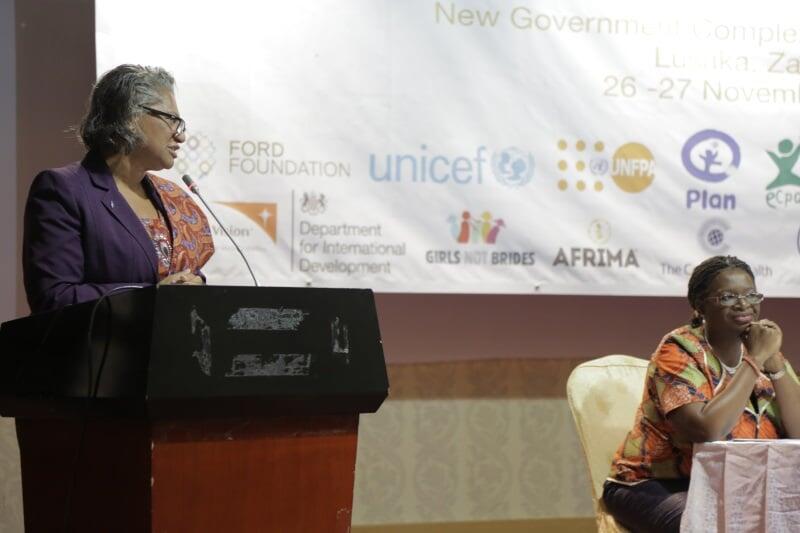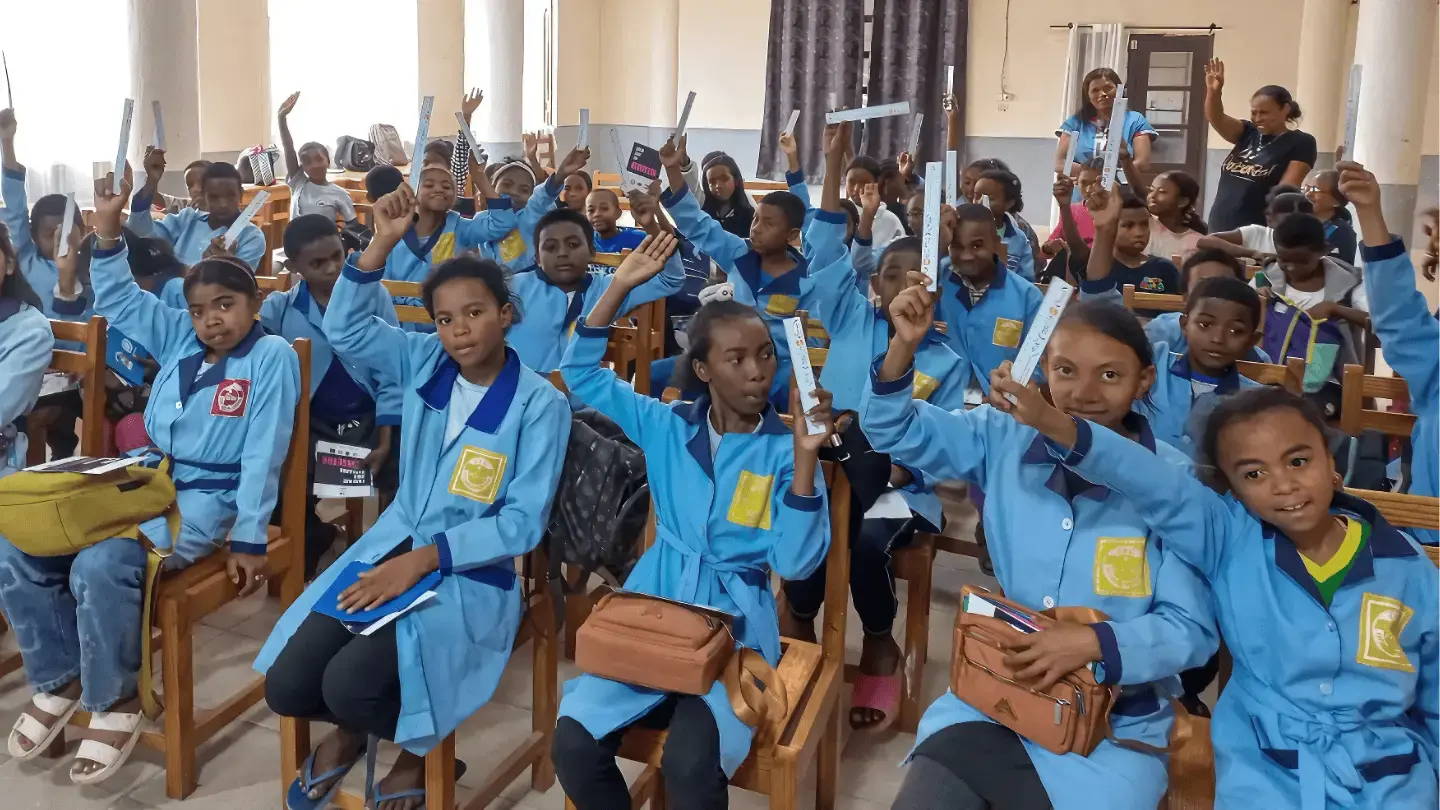Africa will not reduce poverty and realize inclusive economic and social development without the right investments in its youthful population, said Dr. Julitta Onabanjo, Regional Director for UNFPA East and Southern Africa. This includes investing in multi-sectoral interventions to end child marriage.
Speaking on behalf of Dr. Babatunde Osotimehin, UN Under-Secretary General and UNFPA Executive Director, at the closing ceremony of the two-day African Girls’ Summit to End Child Marriage, in Lusaka, Zambia, she said that if child marriage is addressed in the region, the lives of millions of girls will change, providing a window of opportunity to harness Africa’s demographic dividend.
“For the African youth, including the girl child, this means fulfilling their socio-economic development aspirations,” she said.
The summit, the first of its kind, was organized by the African Union Commission with the support of UNFPA, UNICEF and UN Women. It was hosted by the Zambian Government and funded by the governments of the United Kingdom, Canada, Italy, and the Netherlands.
The high-level event was attended by vice presidents, first ladies, AU Commissioner of Social Affairs Dr. Mustapha Kaloko, ministers, deputy ministers, UN agency representatives, and young activists including child marriage survivors.
AU’s transformational agenda
Dr. Onabanjo re-affirmed Dr. Osotimehin’s support to the African Union Commission as it leads a transformational agenda that envisions prosperity for Africa’s 1.2 billion people based on inclusive socio-economic development, to unleash the potential of its women and youth.
A successful passage from adolescence into adulthood is the right of every young person in Africa. This right has not been fulfilled for all young people, particularly adolescent girls, she said.
“It is totally unacceptable that one in three girls in low and middle income countries are married before they are 18, and one in nine by age 15. In the course of this year alone, about 14.2 million girls will become child brides,” she said.
Of 41 countries with a child marriage prevalence rate of 30 per cent or more, 30 are located in Africa. In East and Southern Africa, two out of five young girls are married before the age of 18. “If current rates prevail, the number of child marriages occurring south of the Sahara is expected to double by 2050.”
Child marriage is linked to other development issues:
- Nine out of ten teen births occur in the context of child marriage and these are associated with high rates of maternal mortality.
- Girls between the ages of 10 and 14 have five times the risk of dying during pregnancy and child birth compared to young women aged 20 to 24.
- Infants born to adolescent mothers are more likely to die before their first birthday than those born to young women in their twenties.
Millions of African adolescent girls who have been married off young are subjected to a life of poverty and abuse. “Every girl in this situation is forced to drop out of school and forgo her life’s potentials of becoming a healthy, skilled and empowered woman – all because someone else decided for her!” she said.
Focus on young people’s needs
Member states must position the development needs of young people, including adolescent girls, as they embed the 16 Sustainable Development Goals (SDGs) and 169 targets in development planning processes and identify finances for development.
The needs of Africa’s largest population, its young people, must influence financial allocations and uses.
Young people need freedom to define their lives, to be free from abuse, to pursue their education, and to join the workforce as healthy, skilled and productive individuals. The elimination of child marriage will alter population dynamics in favour of development and help countries invest more in the quality of education, health and other sectors that trigger sustainable development.
It is a matter of rights and choice, and also of ‘smart’ economics.
Africa is on the move in the right direction. Member States are resolute on what needs to be done, as articulated in the summit outcome statement and action plan. “We must continue to change the narrative of child marriage on the continent, as members of a huge movement globally and regionally to end child marriage,” she said.
Actions to eliminate child marriage
In the summit recommendations and outcome statement, actions required to speed up elimination of child marriage include the need to:
- Foster an enabling legal and policy framework and set the age of marriage at 18: eliminating all loop holes, adopting the laws and enforcing them to ensure girls are protected at all times;
- Implement evidence-based, girl-centred programmes using cost-effective strategies to keep girls in school and out of marriage by empowering them with information, skills and quality formal schooling;
- Implement programmes to help married adolescents return to school to climb out of poverty and keep healthy;
- Use data generation, analysis and use to guide programming for married adolescent girls and address inequities;
- Involve parents, religious and traditional leaders and adolescent girls as leaders to end child marriage;
- Pool resources to increase reach and scale to make a difference through measurable results on child marriage;
- Strengthen strategic partnership and coordination efforts to end child marriages.
UNFPA, its sister agency UNICEF, and a growing number of financial partners including the UK, Canada, the Netherlands, Norway, the European Commission and Italy, is spearheading a multi-donor, multi-stakeholder Global Programme to accelerate the movement to end child marriage in twelve countries across four regions. The goal is to protect adolescent girls’ rights, delay age at marriage and childbearing, and empower the most marginalized girls.
The recently adopted Common Position on Ending Child Marriage in Africa calls upon all member states to establish comprehensive action plans to end child marriage.
This includes establishing and enforcing laws setting the minimum age of marriage at 18; scaling up community led and girl-focused interventions; and monitoring and accountability systems.
The trail-blazing SADC model law on child marriage can be used as a reference document by countries developing their own child marriage-related laws.
“Africa’s translation of the 2030 Agenda for Sustainable Development manifests in what we collectively do today to ensure the realization of its young people’s potential, especially adolescent girls – for therein lies Africa’s future,” she said.




